Osprey vs eagle – both are majestic birds of prey. Even better, in many places, Ospreys and eagles have become established, common birds!
Both are large raptors, but there are also several key differences. The Osprey is mostly dark above and white below while eagles have darker plumage overall. One of the other main differences is the food they eat.
While eagles catch a variety of animals and even eat carrion, Ospreys only eat fish. There are other differences too and in this article, we cover all of them! Look below to learn about the differences between Ospreys and eagles, along with tips to identify these big, magnificent birds.
On this page
Body & Shape
Ospreys and eagles have a similar raptor shape, but they are still different. In general, Ospreys aren’t as bulky and heavy as eagles. They are slender, lanky birds with long, slender wings usually held at a slightly bent angle, even while soaring.
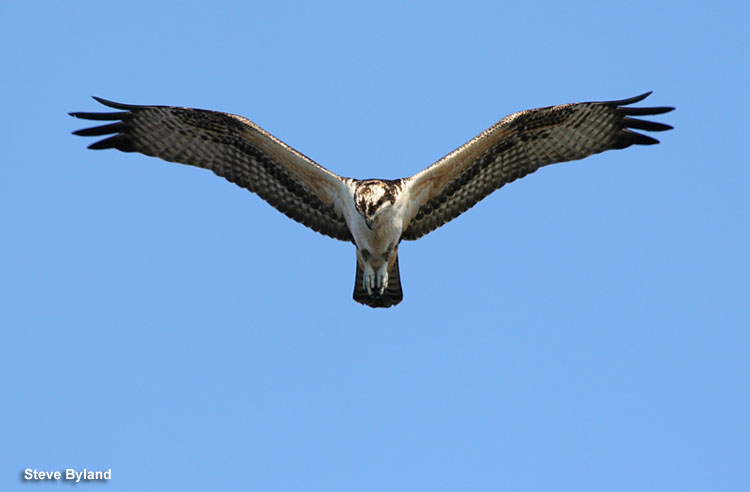
Osprey in-flight
Eagles, on the other hand, have broader wings held straight out from their bodies. The Bald Eagle holds its wings so flat, they are often referred to as a “flying board”! Golden Eagles, though, soar with their wings held in a shallow “V” shape.
Related: Golden Eagle vs Bald Eagle
Ospreys and eagles have similar, broad, medium-length tails, but the Osprey has narrow dark bars on its tail, the Golden Eagle has a broad dark tip, and the Bald Eagle has much white in its tail.
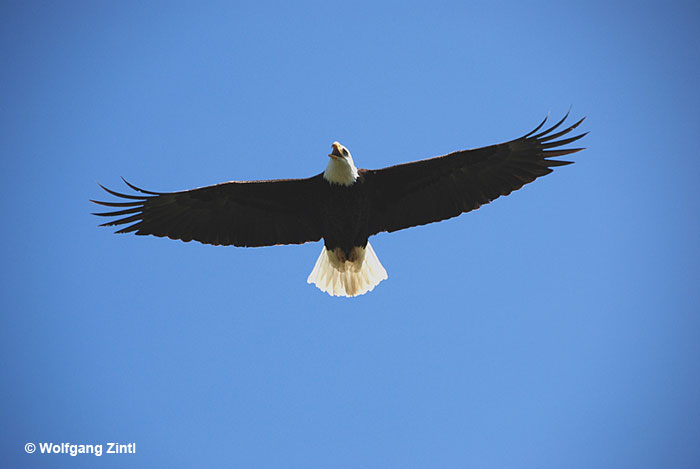
Bald Eagle soaring the skies
In flight, we can also see plumage differences between Ospreys and eagles. Ospreys are always pale below with a dark eye stripe, darker flight feathers, and dark bands on its pale tail.
Like all raptors, the Osprey and eagles also have strong feet with long, sharp talons. However, the bottom of the Osprey’s feet are also covered with small sharp points that help them hold onto fish.
Their beaks are also similar, but the Osprey’s bill is small and has a long, sharp hook. Eagle beaks, on the other hand, are massive hooked beaks adapted for killing larger prey.
Osprey vs Eagle Size
When we compare the size of eagles and Ospreys, there’s no comparison! Both Bald and Golden Eagles are much bigger. While the average Osprey is 23 inches long, the Bald Eagle has a length of 31 inches and the Golden Eagle is 30 inches long.

Compared to eagles, Ospreys are quite a bit smaller. © Alan D. Wilson
Eagle wingspans are also longer. Golden Eagles and Bald Eagles both fly with wings that span six and a half feet! The wingspan of the Osprey is an impressive five feet and 25 inches, but it’s still one foot smaller than the eagle’s huge, broad wings.
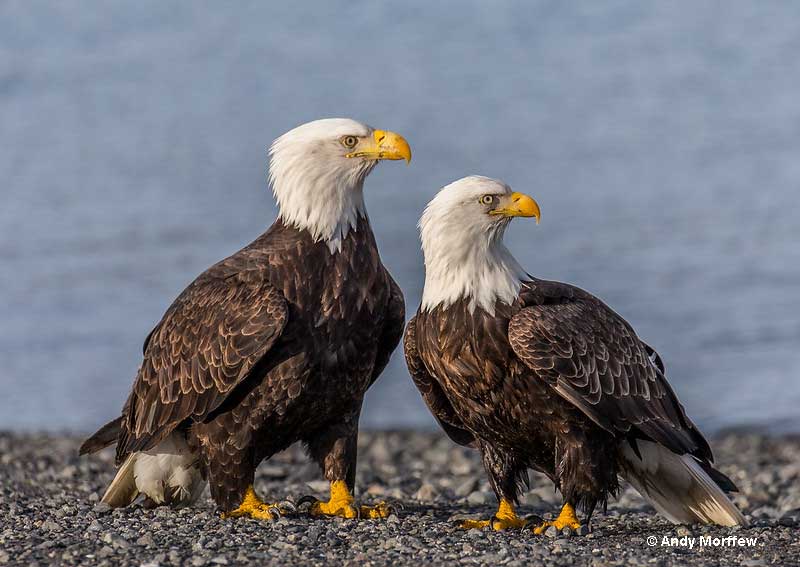
Photograph © Andy Morffew
As expected, Ospreys also weigh less than eagles. The average Osprey is 3.5 pounds, while the Bald Eagle is 9.5 pounds. Weighing in at 10 pounds, the Golden Eagle is a true heavyweight!
When we see these birds in the field, their size differences are pretty evident. In general, eagles look bigger and bulkier, while Ospreys are noticeably lighter in weight and smaller overall.
Osprey vs Eagle – Speed
Both Ospreys and eagles can fly fast when they need to. We often see Ospreys flying over lakes, rivers, and coastal marshes with long wings that make casual, gull-like flaps and glides. However, when they chase other Ospreys or flee from eagles, they can reach impressive speeds of 80 miles per hour!
Ospreys can also soar and fly fast while migrating, sometimes using tailwinds to travel at 50 miles per hour.
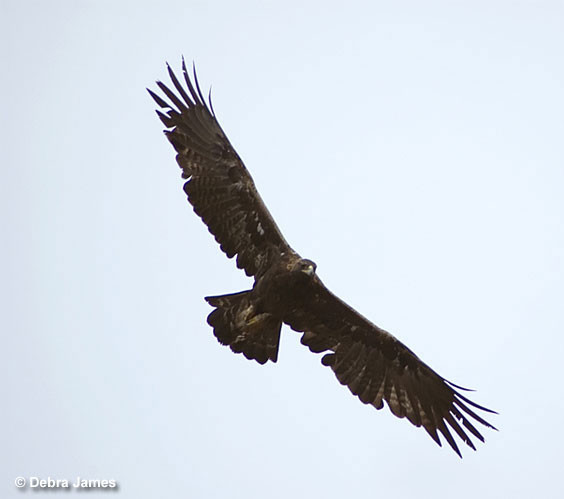
Golden Eagle soaring in the sky
Ospreys are fast, but eagles still fly faster. The Bald Eagle often soars and moves slowly through the air with big deep flaps but don’t be fooled by that supposedly “lazy” appearance. When diving after a goose or ducks, they can reach swooping and diving speeds of 100 miles per hour.
Golden Eagles are even more rapid. In fact, they are one of the fastest birds in the world. Like the Bald Eagle, they also frequently soar high overhead and casually fly with big, deep flaps but can also fly much faster.
True masters of the air, Golden Eagles often reach speeds of 60 miles per hour when chasing prey. However, when diving on birds, rabbits, and other animals, they can fly as fast as 200 miles per hour!
Age
Ospreys and eagles are long-lived birds. With few animals that prey on them, they tend to live longer than most smaller birds. The Osprey is believed to have an average life span of seven to ten years but is also known to live to be 25.
The main factors that affect the lifespans of Ospreys are nest predators such as the Great Horned Owl, Goshawks, eagles, and the occasional mammal. When they reach adulthood, old or sick birds may be killed by eagles, and they can be affected by pollution, but healthy birds don’t have many predators.
The Bald Eagle can live for 20 to 30 years in the wild, although a few captive birds have lived to be 50. Golden eagles have similar lifespans. Since they are rarely preyed on, the main factors that affect eagle lifespans are persecution by people, accidents when they fly into power lines, and pollution.
Osprey vs Eagle Behavior
Ospreys and eagles have some similar behaviors, but eagles are much more powerful birds. Both types of birds also live in some of the same places, although Golden Eagles prefer wild areas.
Ospreys are not aggressive and spend most of their time flying back and forth over water as they search for unwary fish that come too close to the surface.
They can be aggressive when defending their nests, though, and will dive at potential predators, but only when the animal climbs or flies to the nest. Even then, the Osprey might not be able to drive the animal away.
Since Ospreys only prey on fish, they don’t pose any threat to dogs or cats. However, they will attack Koi and other fish in a backyard pond!
Eagles also defend their nests from animals or people that climb up to it. However, unlike the Osprey, they can cause serious harm with their strong talons and large beaks. For this reason, few animals are foolish enough to attack an eagle nest.
Unlike the Osprey, eagles can also pose a threat to small dogs. Since Golden Eagles regularly prey on small foxes, small dogs should never be left unattended in eagle habitat!
Diet
Ospreys and Bald Eagles both catch fish by flying over water and diving down to snatch a fish with their talons. However, Ospreys dive deeper into the water and won’t eat anything but live, fresh fish.
Bald Eagles, on the other hand, vary their diet with dead fish, carrion, ducks, geese, and occasional small mammals. They catch these animals by swiftly gliding in and catching them with their talons.
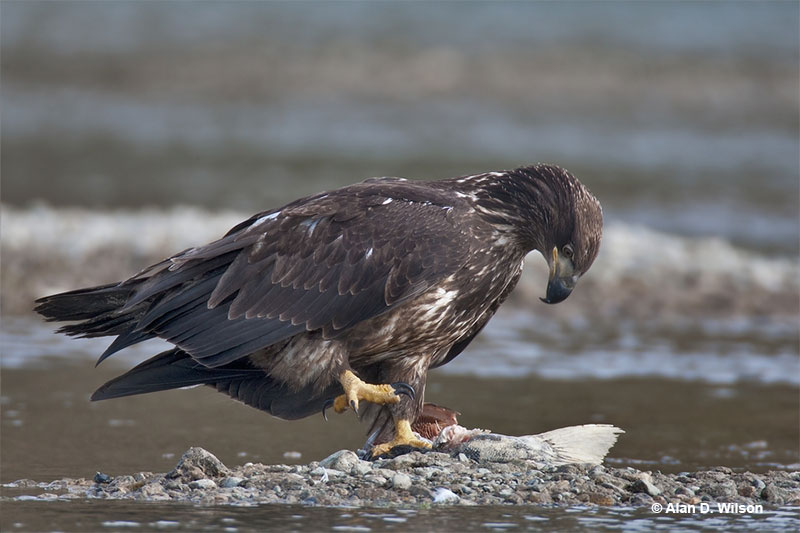
Juvenile Bald Eagle enjoying a meal. Photograph © Alan D. Wilson
Unlike Ospreys and Bald Eagles, Golden Eagles are not tied to water and don’t usually feed on fish. Instead, these powerful birds catch small and medium-sized mammals up to the size of a fox. They also catch birds and can take other raptors, small cranes, and other species.
In some places, they also knock goats off of cliffs to then feed on the carcass down below!
They catch all of their prey by swiftly flying and using their talons to snatch the animal on the ground or in flight.
Osprey vs Eagle Location
Ospreys and eagles live in many of the same places. Ospreys and Bald Eagles are usually found around lakes, rivers, coastal marshes, and other bodies of water, although they can also fly over land and cities during migration.
Thanks to protection and other conservation efforts, as long as water is present, we can also see Ospreys and Bald Eagles in many urban areas.
Golden Eagles prefer wilder places. They breed in northern habitats in Canada and Alaska, and in forest and open habitats in the western USA and northern Mexico. They also migrate to southern Canada and the western and southern USA for the winter.
Ospreys breed on the eastern coast and in Alaska, Canada, and parts of the northern and western USA. They migrate to Florida, California, some other coastal areas, and wetlands as south as the Amazon.
Bald Eagles have a similar breeding range but live in more areas and winter in much of the USA and parts of southern and western Canada.
Nest & Eggs
Ospreys and eagles also build similar nests. The Osprey and the Bald Eagle both make big, bulky stick nests in a tree or on a platform in or near a marsh or other wetland. They can also use the same nest year after year, the nest increasing in size with each year of use.
Golden Eagles make similar, huge bulky nests of sticks, bones, and other hard items. They can also use the same nest year after year but usually build the nest on a cliff, or in a tree in an open area, and not near water.
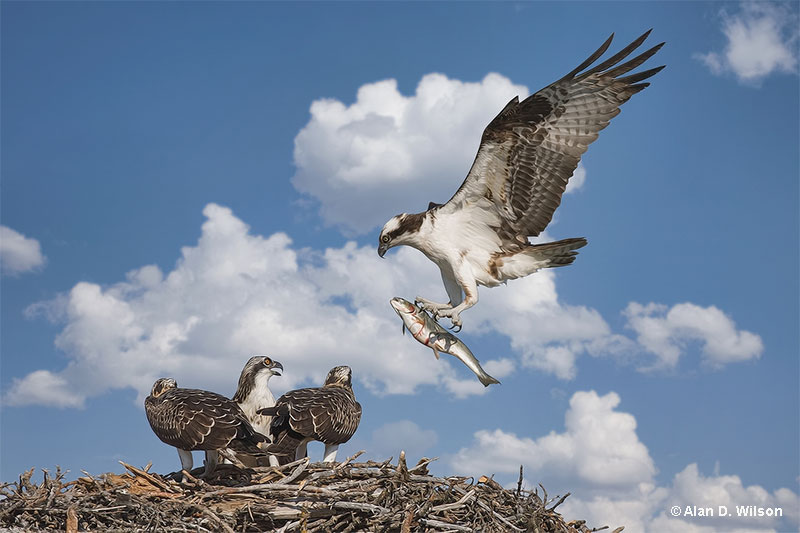
© Alan D. Wilson
Ospreys lay one to four cream-colored eggs with reddish markings. They are around 2.5 inches long, weigh 2.3 ounces, and are incubated by both sexes for 37 days.
Bald and Golden Eagles lay one to three eggs around three inches in length. Bald Eagle eggs weigh 4 to 4.6 ounces and are dull white. Golden Eagle eggs weigh around 5 ounces and are cream-colored with some brown markings.
Bald Eagles incubate their eggs for 34 to 36 days, but Golden Eagles incubate for 41 to 45 days.
Learn more: Baby eagles
Osprey vs Eagle – Frequently Asked Questions
What is the difference between an Osprey and an eagle?
The difference between an Osprey and an eagle is that Ospreys are smaller, white below, mostly dark above, have contrasting dark flight feathers, and only feed on fish. Eagles are bigger, stronger, and have darker plumage.
Is an Osprey a type of eagle?
No, although the Osprey is sometimes known as a “Fish Eagle”, it is not an eagle and is in its own family, the Pandionidae.
Do ospreys and eagles get along?
No, Ospreys and eagles do not get along. Eagles often chase Ospreys to steal their catch, sometimes prey on their young, and occasionally kill adult Ospreys.
What is so special about Osprey?
The Osprey is a special bird that only feeds on fish and is the sole member of its family. The bottom of its feet are also covered in small spiny points to help it hold onto wet and slippery fish.

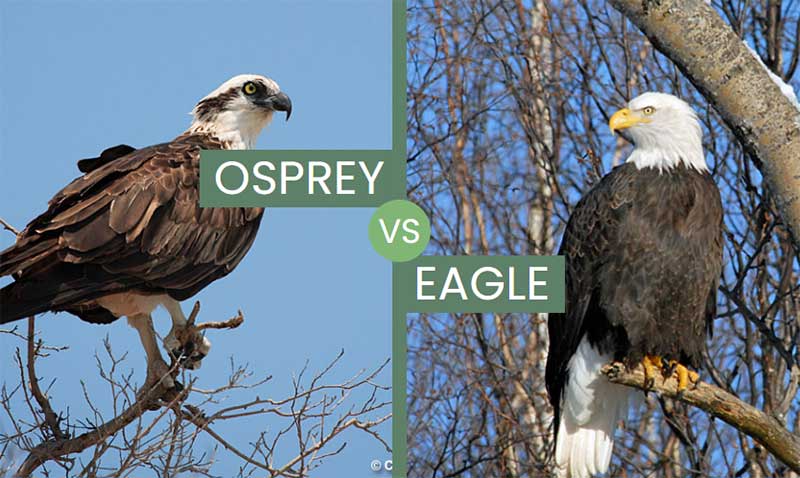

Elizabeth
Tuesday 5th of March 2024
Thank you for your easy to understand comparison of Osprey's and Eagles. Always enjoyed watching the Bald Eagle who used to fish from our backyard shoreline when we lived on a lake in Pennsylvania. My Aunt lived in Minnesota and maintained a Bluebird trail and somehow helped Ospreys at her large country property where she built a cabin. I would watch the Osprey's fish and was always fascinated with them.